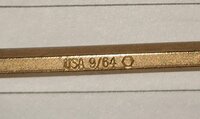Quick update on this for anyone contemplating buying an OE Pharos:
I wanted to send the unit back, as I was (and remain) dismayed at the speed with which the adjustment bolt rounded out. However I really should have checked the fine print on returns before buying - I hadn't spotted the 15% 'restock charge', so coupling that with the postage fees I would be massively out of pocket. In the UK such fees are unheard of: if it's likely a manufacturing fault the company are obligated to replace or refund free of charge.
OE sent me a replacement adjustment collar, gratis. This was appreciated, however immediately on receiving the part I checked it against two newly-bought high quality 3mm Allen keys, and there was significant play evident in the interface.
I suspect it's actually a 1/8 bolt (3.5mm, not 3mm). So I've ordered a 1/8 Allen key to see if that helps. Nevertheless the bolt quality is poor, the metal rounds very easily even at low torque settings, so I will look to replace it with a hardened metric equivalent.
If anyone's interested I can post up the minimum torque settings I've found necessary to prevent collar slip with light-roasted coffees, I have them around somewhere.
Summary of this grinder:
- Grind quality is excellent.
- It's hard work with light roasts and you'll almost certainly need something to dog it to a bench or worktop.
- The adjustment system is not great out of the box: before installing put some copper-slip on the bolt and use caution torquing it up.
- Don't expect sympathy from Doug & Barb if you round out the bolt.
Hearing this makes me appreciate Baratza that much more. Obviously with grinders, manual or electric, things can and will go wrong which makes finding a manufacturer that stands behind their product that much more important. Even things that can be attributed to user error should be eliminated during the design phase of the product and I suspect that you are not the only one who is having the kind of issues you are having. That should be a message to the manufacturers that either they need to tweek the design or be more forthcoming with instructions on the proper tools to use for making adjustments. Sorry to hear about your troubes but it doesn't seem to have stopped you from enjoying a good cup of coffee. Cheers.
Last edited:



